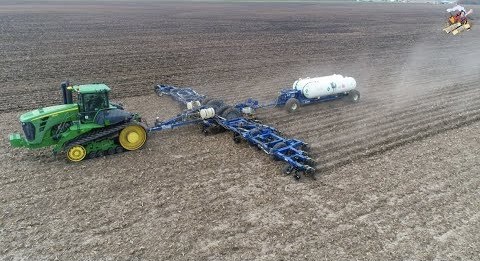Avoid applying fall anhydrous in northern, central Missouri

COLUMBIA, Mo. — University of Missouri Extension state nutrient management specialist John Lory advises against fall application of anhydrous ammonia anywhere in Missouri.
Fall application increases the risk for substantial losses in the period between fall and when the corn needs the nitrogen in June and July.
Instead, preplant and side-dress applications to minimize potential losses of applied nitrogen, he says.
Apply into cold soil
Farmers in the southern third of Missouri generally do not apply fall nitrogen before corn planting because warm soils and wet springs often lead to nitrogen loss. In contrast, many farmers in the northern two-thirds of the state take advantage of cooler soils to fall-apply some of their nitrogen, Lory says. This reduces spring workload and takes advantage of lower nitrogen prices.
One way to reduce nitrogen loss from fall-applied anhydrous ammonia is to apply it into a cold soil to prevent the conversion of ammonium to nitrate, he says. In warm soil, anhydrous rapidly converts to nitrate, a form of nitrogen prone to leaching and other losses. Soil temperature needs to be at or below freezing to fully eliminate conversion.
’50-degree rule’ doesn’t work in northern Missouri
Many farmers are familiar with the “50-degree rule” for anhydrous ammonia application. This old rule of thumb says farmers should delay anhydrous injection until average soil temperature at 6 inches is below 50 degrees Fahrenheit. “My evaluation of soil temperature data from Missouri, Illinois and Iowa indicates the 50-degree rule does not work in northern Missouri,” said Lory in a press release. “Instead, delay anhydrous applications until the 6-inch soil temperature drops below 40 degrees.”
The 50-degree rule comes from Minnesota, Iowa and other states north of Missouri, explains Lory. There are significant differences in over-winter soil temperature patterns in northern and central Missouri compared to Iowa and northern Illinois. In areas north of Missouri, winter soil temperature frequently drops below 32 F and rarely rises above freezing through the winter.
“In northern and central Missouri, we typically have some warm weather in January and February that allows soil temperature to rise well above freezing. Soil temperatures rarely fall much below freezing,” says Lory. “These warm-weather events in winter make fall-applied nitrogen less stable in Missouri compared to our northern neighbors.”
Farmers in the northern half of Missouri can compensate for some of these differences by delaying anhydrous ammonia injection until fall soil temperatures are lower. Using a 40-degree rule offsets many of the differences between Iowa and Missouri.
“The later you apply, the more likely the anhydrous will make it through the winter without converting to nitrate,” says Lory. Another approach is to add a nitrification inhibitor like N-Serve with your nitrogen fertilizer.
Delays come with weather risks
The downside to delaying fall anhydrous applications is that weather conditions can make application difficult. Waiting for soil temperatures to approach 40 F may delay application a month. In a typical year, average 6-inch soil temperature at Novelty, Mo., reaches 50 F around Oct. 27 and 40 F around Nov. 24.
You can track fall soil temperatures at 6 inches at http://agebb.missouri.edu/weather/reports/soysoil6.asp.
“We know farmers face real challenges as they plan nitrogen fertilizer applications,” says Lory. Fall applications take advantage of good field conditions but, in many years, will convert to nitrate in fall or early spring. This makes them prone to leaching and other losses with excessive rainfall, particularly in spring.”
Preplant applications also leave nitrogen vulnerable to losses in the spring. Moving to split or side-dress applications during the growing season is a recommended 4R practice, but wet spring conditions can impede timely nitrogen fertilizer applications, he says.
In northern Missouri, fall nitrogen applications do not lead to losses every year, but farmers need to be aware of the risks and take steps to limit them.
Limiting fall anhydrous ammonia applications to less than half of planned corn and milo acres also helps to manage risk. Also, stay aware of spring soil conditions and be prepared to supplement nitrogen on fall-fertilized fields in wet years, says Lory.
Miss Clipping Out Stories to Save for Later?
Click the Purchase Story button below to order a print of this story. We will print it for you on matte photo paper to keep forever.

